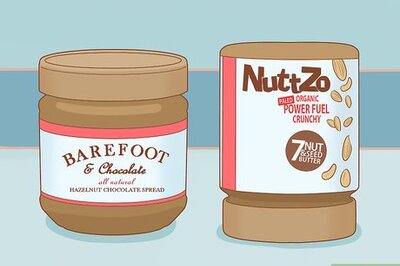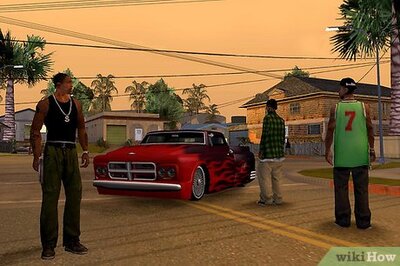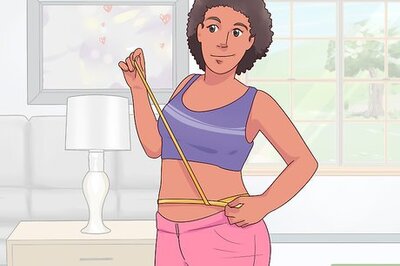
views
Heels
Stilettos Ah, the stiletto heel. One of the sexiest shoes on the planet. Stilettos are characterized by a steep slope and a thin, high heel that is less than 0.5 in (1.3 cm) in overall surface area where they sit on the ground. The name “stiletto” comes from the name of an Italian knife with a very thin, slender blade. The heels on these shoes are similarly thin and pointy. When to wear them: Maybe don’t break them out for a work event or funeral, but if you want something impressive for date night, stilettos are the right shoes.
Wedges Wedge heels refer to any heeled shoe where the heel covers the vast majority of the ankle. The heel either tapers off towards the front of the toe or leads directly back to the sole near the ankle. Wedges tend to sit at a soft, comfortable height where the foot naturally has an easy time balancing and resting. This makes them a fun, comfortable option for a lot of people who want a heel without the foot pain. When to wear them: Any time, any place! The right pair of wedges can be suitable anywhere.
Block Heels Block heels are similar to wedges in the sense that they have thicker, wider heels. However, block heels tend to be more dramatic and expressive. Also, the heel never tapers—it stands more on its own as a kind of feature of the shoe. Block heels and wedges tend to be the kings when it comes to comfortable heels you’d want to wear for a longer period of time. Block heel shoes are sometimes called chunky heel shoes. When to wear them: Block heels can work in more formal situations, but they’re typically not appropriate for serious events.
Kitten Heels Kitten heels are a type of stiletto heel with a very low profile. They also tend to have slightly curved heels that provide more support and stability than other shoes with thin heels. These low-profile heels are a comfortable, smooth in-between option when you’re looking for something more comfy than a pure stiletto but more dramatic than a flat. The name “kitten” heel refers to the fact that they’re often the first type of heel young women wear. Thus, a heel for young kittens, not adult cats. They were actually considered to be a kind of “training heel” when they first appeared on the scene! When to wear them: Kittens can work in basically any situation or scenario, depending on the outfit.
Slingback Heels Slingbacks are very similar to stilettos with one major exception: they have a distinctive and fancy strap that runs around the top of the heel. This strap gives slingbacks their distinctive, often luxurious vibe. When to wear them: Slingback heels are most appropriate when it’s nice enough outside to wear sandals, since they don’t cover very much of your foot. Most slidebacks are too flashy for a job interview, but they’re an extremely sleek option for any high-fashion event, date night, or outing with friends.
Peep-Toe Heels Peep-toes are a subtype of slingbacks, booties, or other dress shoes. They’re defined by the slight gap in the front of the shoe where the wearer’s toes are visible, but the main body of the foot is covered. When to wear them: They’re no good if you’re going to court, interviewing at an office, or going to a funeral, but otherwise, peep-toes are a stylish and fun option for any situation.
Platform Heels Platform heels refer to any heeled shoe with a sole that measures between 1–4 inches (2.5–10.2 cm). The large soles increase the wearer’s height and create an extremely expressive and elongated appearance. Platform shoes go all the way back to Ancient Greece. Greek theatre actors would wear the platforms to make it easier for the audience to see them. Platform shoes without a separate heel are simply known as platform boots or platform shoes. When to wear them: They’re not appropriate for work most of the time, but if you’re looking to make a statement with some fun footwear, platform shoes are a great option!
Boots
Ankle Boots Ankle boots refer to any boot (usually heeled) where the fabric of the boot barely covers your ankle. These aptly-named boots are stylish, versatile, and easy to style. They also offer a little bit of protection in the winter, while not being so heavy or thick that they’re uncomfortable to wear in the summer. Booties aren’t the same thing! A “bootie” refers to a boot that ends right at the ankle. Ankle boots, by definition, cover the ankle. When to wear them: Any time you’d like! Ankle boots are extremely versatile and lend themselves quite nicely to basically any situation or outfit, including jeans or dresses.
Knee-High Boots Knee-highs are dramatic, expressive, and iconic. They’re defined by their high leg barrels, which end either at or just below the knee. These boots are a popular option among fashionistas. They’re also great with a dress or shorts in the summer, or as an additional layer over pants in the winter. Calf-high boots are slightly different. As you can probably guess, calf-high boots end in the middle of the calf. They’re very similar to knee-high boots, but stand out just a little bit less. When to wear them: Knee-highs are a little flashy for a funeral, but they can be a fun option in basically any other scenario. They’re also a great option if you want to wear a dress but the weather isn’t pristine.
Combat Boots Also known as tactical boots or military boots, combat boots are about as tough and durable as footwear gets. These (often-expensive) boots are made with tougher materials than you’d find on a traditional boot, and they’re often very heavy to wear. These boots are all about protecting the wearer from danger. There are also more stylish variations that are popular in the world of high fashion and in punk/goth subcultures. When people refer to designer “combat boots,” they’re describing any kind of boot with a bulkier profile and a design inspired by actual combat boots. When to wear them: If you want to make a statement, combat boots will help. They’re immediately recognizable, and their edgy, bulky profile can really shift the energy of an outfit.
Work Boots Work boots are what they sound like: boots designed for work. These boots are a necessity on any construction site or job involving hard labor. They often have thick soles and reinforced heels and toes to avoid damaging your feet or accidentally puncturing your foot with a nail. Work boots often have steel toes (also known as steel-toed boots), which refers to an actual steel cap that sits inside the boot material on the top of the toes. It protects your toes from getting crushed or injured by heavy items. When to wear them: Wear work boots on the job site, when it’s cold out, or if you’re doing something physical (like going paintballing or gardening).
Chelseas Chelsea boots are a popular and stylish option for men and women. These versatile boots are defined by their lack of laces, their smooth (often leather) curves, and the elastic side gusset, which makes the boots easier to put on or take off. Why are they called “Chelsea” boots? Chelsea boots are named after a neighborhood in London (called Chelsea) where these boots were originally popular. When to wear them: One of the things that makes Chelseas so popular is their versatility. You can wear them basically anywhere!
Hiking Boots Hiking boots are a necessity for serious hikers. If you sprain an ankle or break a toe in the middle of a remote area, a relaxing hike can turn into a life-or-death situation. So, hiking boots have a ton of support, comfort, and structural reinforcement for a healthy foot position. They are also often waterproof and thick to protect your feet in tough environments. Hiking shoes are a great option for more laid-back hikes. You don’t need the extra bulk and support if you’re just walking on calmer trails. When to wear them: Hiking boots aren’t the most fashionable, but if you’re doing anything outdoors, they’re appropriate.
Cowboy Boots If you ever feel like shouting “yee-haw” and rocking a 10-gallon hat, you probably want a pair of iconic cowboy boots to complement your vibe. Cowboy boots are defined by their leather material, fancy stitching, high arch, and Cuban heel. How do you break in cowboy boots? Adrian says, “It depends on the leather. Some people like to use mink oil. Some people don't like to use mink oil because it darkens the leather so they use just a leather conditioner. But basically, you just have to brush the material into the leather. Keep applying the oil or conditioner until the leather breaks in and becomes soft.” When to wear them: Cowboy boots are a fun way to elevate an otherwise typical outfit. If they’re more on the subtle side, you can pull them off during more “serious” events, but they’re often too fun to wear to funerals, interviews, etc.
Wellingtons (Rain Boots) Bet you didn’t know rain boots were called Wellingtons, huh? Well, they are. Wellingtons are tall, rubber boots designed to keep your feet dry. They also come in some very stylish and unique designs—you aren’t stuck wearing the goofy cliche yellow boots of yesteryear anymore. “Wellingtons” are named after Arthur Wellesley, the Viscount and Duke of Wellington. He was a prominent politician and fashionista who pioneered the rubber boot. In some parts of the world, Wellingtons/rain boots are called rubbers or gumboots. Adrian says that if you want to stretch Wellingtons to make them comfier, use hot water. “You can put the boots in hot water so the rubber can become a little bit softer. And then you can use a boot stretcher.” When to wear them: Wellingtons can look kind of weird if it’s not raining (or at least overcast), but if they’re stylish, you can pull them off in a surprising number of scenarios.
Winter Boots Also known as snow boots, winter boots are all about keeping your feet warm and dry. They have thick interiors, waterproof exteriors, and thick, grippy soles to keep your feet from sliding all over the place when you’re walking on wet or icy surfaces. If you go inside and outside frequently during the winter, consider looking for a pair of slip-on snow boots. Traditionally, winter boots have huge lace setups that can be kind of a pain to put on and take off. When to wear them: Winter boots are best when it’s freezing out!
Riding Boots Riding boots are worn by equestrians, but they’re also a popular option among fashion-forward folks who don’t partake in horse-riding. They have a tall profile and reinforced hides to give them a stiffer, more uniform look. They also tend to have intricate leather details and buckles. There’s a variation of the traditional riding boot known as paddocks. They resemble Chelsea boots with a stiffer material, and they’re mainly designed for children learning to ride horses. When to wear them: They won’t be appropriate at a wedding or in most offices, but riding boots are a high-fashion statement piece with the right outfit if you’re going out.
Sandals
Flip-Flops Flip-flops are a sandal-style footwear defined by the goofy noise they make when you walk in them and let the soles slap. They feature flat soles, open toes, and a Y-shaped strap that runs between your toes to help keep the flip-flops in place. What are sandals, anyway? “Sandal” is a category of shoe. It’s defined by how the sole is attached to the foot. For sandals, the sole must specifically be strapped to the foot—the sole can’t be connected to material that covers the entire foot. When to wear them: At the beach or on a relaxing stroll. Don’t break flip-flops out if the weather isn’t perfect or you’re going to a formal event.
Slides Also known as sliders, slides are a type of sandal characterized by how easy they are to put on and take off. They rely on a single (usually thicker) strap, and your toes slide underneath the strap to hold the shoe in place. They’re extremely comfortable, and they’re often cited as offering more foot support than flip-flops or flats. When to wear them: Slides are for casual settings when the weather is nice.
Gladiator Sandals Gladiator sandals, also known as strappy sandals, are a style of sandal where there’s an elaborate lacing system and no large sheet of fabric or material that connects the sole to the foot. They come in a bunch of different styles, but they’re generally great options if you want something distinct, visually impressive, and comfortable in hot weather. Gladiator sandals are notorious for having functionally zero arch support, so they’re unlikely to be the best option if you have sensitive feet. When to wear them: If the weather is nice, you can wear gladiator sandals basically anywhere where it would be appropriate to wear a sundress.
Slippers Slippers are a type of (typically indoor) shoe with a covered front and an open ankle. This keeps the front of the toes nice and warm while maintaining easy access when you put them on or take them off. When to wear them: Slippers are worn at home. They’re also appropriate if you want to wear a robe and yell at kids to stay off your lawn while you wave a newspaper from the driveway!
Dress Shoes
Flats Flats are pretty straightforward. They refer to any women’s footwear with no separate heel. In other words, the sole of the shoe is…well, flat. They come in basically every shape, style, and material imaginable. Some “flats” do have a very tiny heel. These flats are technically called “low-heel” flats, although people often just bundle them together. Do you have trouble keeping flats on your feet? Victor Adrian says there are pads you can put on the back of the heel to keep the shoe from going up and down when you walk. “You can also put on some thicker socks that will keep the shoe in place,” he explains. When to wear them: It completely depends on the style and design of the flats, since flats come in all kinds of different aesthetics.
Loafers Loafers are a category of shoe that comes in a variety of different styles. The key binding characteristics are that they’re leather or suede, they’re slip-ons with no fasteners or laces, and they’re low-profile. Loafers are considered a quintessential cornerstone of any man’s wardrobe, although they’re quite popular with women as well. Penny loafers refer to loafers with a thin strap that runs on top of the foot. There’s a slot on the strap about the width of the penny, ergo the name. Tassel loafers have decorative little tassels on top of the shoe. Horsebit loafers have a distinctive buckle that gives them a kind of luxurious look. When to wear them: Pretty much any time you’d like. Loafers are a comfortable and straightforward footwear that will work at a wedding, a funeral, or a fun day out.
Oxfords Oxford shoes refer to any kind of dress shoe where the shoelace eyelets are stitched directly into the vamp, which is the term for the main material of the shoe where the middle of the foot is covered. Think of Oxfords as dress shoes with closed laces; the impression created by the design is that the laces aren’t a key feature of the shoe. They’re named after Oxford University, where the shoes first became popular in the 1800s. Wingtips are a popular style of Oxford where the vamp takes the shape of two distinct wings (which is where the name comes from). They’re considered the most stylish variation of an Oxford. When to wear them: Any time! Oxfords are dress shoes, but you can also wear them casually.
Derbies Derbies look a lot like Oxfords with one big difference—the Derby has open laces that sit on top of the vamp. That’s it. The ultimate effect is that it makes the shoes look more elaborate and fashion-forward. That said, Derbies are also cited as being more comfortable than traditional Oxfords because the top of your foot has more wiggle room. It is believed that the name “Derby” comes from the 14th Earl of Derby, Edward Smith-Stanley, who was a larger guy. Given his size, he wanted a larger shoe with more room for his large weight, so he commissioned boots with a more open lace system. When to wear them: Like the Oxford, Derbies are appropriate in basically any setting. They’re dress shoes that can comfortably work as a casual and stylish option in laid-back situations.
Mary-Janes Also known as bar shoes, doll shoes, or straps, Mary-Janes are a kind of low-profile, low-cut shoe with one or more straps that run over the center of the foot. They typically have very simple designs, and the shoes are normally made out of leather. There are heeled versions of Mary-Janes out there. Mary-Janes are named after a comic, Buster Brown. There was a character named Mary Jane who wore these shoes. When to wear them: These are a cornerstone of kinderwhore and Lolita subcultures, so if you’re going for a cute, alt-look, Mary-Janes are a great option.
Brogues Brogues are a type of shoe (or low-rising boot) with a low heel and multiple layers of leather. They tend to be very elaborate and highly decorative, often with lots of little dimples in the leather (called “broguing”). People often confuse brogues with wingtips because they both tend to have the W-shaped design, but the layers of leather give brogues away. When to wear them: Brogues were originally seen as “country” wear, but they’re now considered a versatile dress shoe you can wear basically anywhere. They can dress up jeans and a shirt or bring a fun texture to a suit.
Athletic Shoes
Running Shoes Running shoes tend to be lighter than other leisure or athletic wear so that you can run long distances without the weight dragging you down. They also often have a lot more cushioning and arch support so that you don’t irritate your feet over time. Walking shoes exist, too! They don’t tend to be as popular to wear casually, but walking shoes are more flexible and thicker than running shoes. They’re designed to be more comfortable, specifically when walking. When to wear them: If you’re doing anything casual, like running errands, hanging out, or hitting the gym, running shoes are great.
Basketball Shoes Basketball shoes have additional cushioning around the edges and sole so that you don’t hurt your feet when you jump, pivot, or sprint. They also tend to have flatter, grippier soles to help maintain traction on a gym floor. Basketball shoes are super popular daily kicks. People often wear Nike, Puma, Under Armour, or Adidas pairs designed for basketball as their casual shoes. That’s because basketball shoes tend to be very comfortable, breathable, and stylish. When to wear them: Basketball shoes are great casual sneakers if you like streetwear vibes.
Tennis Shoes Tennis shoes look a lot like running shoes design-wise, and they do have a lot in common (both tend to be lightweight and breathable). Tennis shoes have extra cushioning and support in the sides of the shoe, though. This makes horizontal movements like strafing or shuffling a lot easier on the feet. I thought tennis shoes were just regular footwear? In parts of the US (specifically the West Coast and Pacific Northwest), people will often use “tennis shoes” as a synonym for “sneakers” or “gym shoes.” Actual tennis shoes are a distinct category, though. When to wear them: Basically anywhere you’d wear casual sneakers, tennis shoes will be appropriate. They’re also great walking shoes if your feet tend to hurt after a while when you’re on your feet.
Casual Shoes
Sneakers The term “sneaker” comes from an old advertising campaign—when these shoes hit the market, their rubber soles made them quieter than leather shoes when you walk. Thus, wearing them helps you sneak around. Today, “sneaker” is a catchall term for any casual shoe with a rubber sole meant for daily wear. Examples of common sneaker brands include Converse, Jordan, Allbirds, Reebok, Nike, K-Swiss, and Adidas. Sneakers are also known as trainers in the United Kingdom, gym shoes in parts of the American Midwest, and athletic shoes in parts of the American South Sneakers are the most popular targets for scammers. Dubinick breaks down the best way to spot fake shoes: “If you shine a blacklight on the shoes and see dotted lines around something like the Nike check or other fabric sections, they’re fake. Factories that produce counterfeit shoes use invisible guide marks to cut the materials, but real shoes never have those.” When to wear them: Wear sneakers anywhere except a church, funeral parlor, or office space!
Skate Shoes Skate shoes have very thick soles with uniform sides. This prevents physical injury and excess wear and tear on the side and bottom of your foot when you ollie, which is the most common maneuver on a board and the foundation of basically every trick in skateboarding. Skate shoes also have extremely grippy soles so you don’t slide off the board mid-air. Skate shoes come in three different profiles: high top, mid top, and low top. If you have weaker ankles, high tops offer more protection and support. Low tops are best for skaters who want more flexibility, while mid tops are a compromise between the two styles. When to wear them: If you’re skating, running errands, or just hanging out with your friends, skate shoes can work. They’re good all-purpose sneakers.
Canvas Shoes Many shoes we’ve covered are defined by what they’re used for. Canvas shoes are our first shoe type that is wholly defined by its materials. If the shoe is made (mostly) of fabric or textile—as opposed to leather, rubber, or plastic—it’s a canvas shoe! Canvas shoes are super breathable, stylish, and easy to clean, which makes them a popular everyday shoe. Converse, Vans, Vessi, Allbirds, and New Balance are all known for their canvas shoes. What type of shoes are Converse? The traditional Chuck Taylors are canvas shoes, but they’re also considered sneakers, since they have a rubber sole. When to wear them: Canvas shoes are appropriate for any laid-back hang or coffee date. Just don’t put them on when it’s raining or snowing—when canvas shoes get wet, they stay wet for a long time.
Boat Shoes Boat shoes were invented by an avid sailor in 1935 who wanted comfortable shoes with extra traction so they didn’t slip on a wet boat deck. Modern boat shoes have rubber soles with (usually) waterproofed leather on top. They also have a unique lacing system that loops around the heel of the shoe to provide extra insurance that the shoes won’t fly off in a capsizing incident or rogue wave event. When to wear them: Boat shoes are pretty appropriate anywhere near water. Beyond that, you likely only want to wear them if it’s nice out and you’re up to something casual.
Mules Mules (and mule heels) are a very distinct and historic style of slip-on shoe. The sides of the mule tend to taper at strange, often asymmetrical angles to make the front of the shoe stand out more. Mules do not have laces, although they often come with a strap or buckle to help hold the shoe in place. Birkenstock’s popular “Boston” style shoe is an example of a mule. When to wear them: Mules are generally only wearable when it’s nice out. They’re only appropriate for casual outings.
Espadrilles You may not recognize the word “espadrilles,” but you’ve seen these shoes everywhere. Inspired by Spanish summer footwear, espadrilles are fabric shoes that feature no laces or fasteners, so they must be slip-ons by definition. They also tend to have a layered look and often appear as if the fabric on the top of the shoe tucks into the sole or covers a lower layer of fabric. Espadrilles can be heeled or flat. In fact, espadrilles with a wedged heel are potentially more popular than the standard flat variety. When to wear them: These are quintessential chill-wear. If it’s nice out and you’re doing something laid-back, espadrilles are a fun option.
Moccasins Today, moccasins refer to a soft, flat shoe made from leather or some other animal-based material (like deerskin). They are stitched together at the top of the shoe and may or may not feature a simple lace mechanism to secure the shoes on your foot. The roots of the shoe design were inspired (or stolen, depending on your perspective) by Native American tribal footwear. It should be noted that what we look at today as the iconic Native American footwear style is really just one example of what indigenous people would wear on their feet. Native American shoe styles are just as historically diverse and different as every other culture on the planet. When to wear them: Moccasins are pretty casual footwear. They’re only appropriate if you’re going to hang out with friends, hitting the town shopping, or doing something else inessential.
Clogs The stereotypically Dutch shoes known as clogs are comfortable, simple, and easy to clean. They’re made from leather or wood and feature no laces and a big, bulky profile that makes your feet appear bigger than they are. Crocs are not clogs! While clogs do share a lot with Crocs design-wise, the fact that Crocs are made out of waterproof plastic makes them categorically distinct from clogs. When to wear them: If you feel like making a statement with your funky, casual footwear, clogs are fun.
Speciality Shoes
Cleats Cleats are specialty footwear designed to improve your performance in a specific sport. They have spikes, called studs, on the bottom of the sole to dig into the ground/floor and provide more stability. Different sports require different cleats because the stud pattern and stud type are unique from activity to activity. For example, golf cleats have a lot of thin, small studs to help the golfer stay put when they swing. Soccer cleats, on the other hand, have fewer studs, but they’re bigger and softer, which offers someone more stability and freedom when they run. Baseball cleats also have larger studs, but they have a reinforced toe specifically to help with pivoting or rotating when stealing a base, swinging a bat, or throwing a ball. When to wear them: When you’re playing the game they’re designed for.
Climbers Climbing shoes are specialty footwear that helps climbing and bouldering enthusiasts stay stable. Climbers fall into two different categories. Flat climbers: Flat climbers are best for indoor climbers and climbers who mainly tackle vertical walls or slabs. The firm, flat shoe makes it easier to stabilize yourself on tiny edges. Downturned climbers: These shoes have very dramatic arches. They’re designed for bouldering or climbing problems that involve a lot of drop knees, toe hooks, or sidepulls where you need to use your toes to hang or support your weight horizontally. When to wear them: Climbers look pretty odd if you aren’t actively climbing or at the gym.

















Comments
0 comment